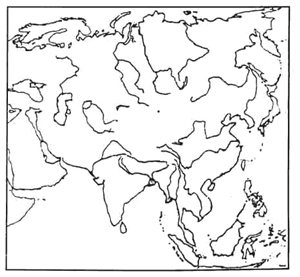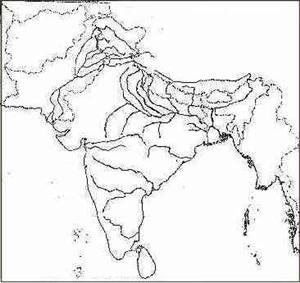(Geography) ICSE Class X Important Questions : Geography (2004)
Disclaimer: This website is NOT associated with CBSE, for official website of CBSE visit - www.cbse.gov.in
Paper : ICSE Class X Important Questions : Geography (2004)
General Instructions
- Section A is compulsory. All questions from Section A are to be attempted.
- Answer any two questions from Section B and answer any three questionsfrom Section C.
- The intended marks for questions or parts of questions are given in brackets [ ].
To be supplied with this Paper: Survey of India Map Sheet No. 45 D/7 and 20 cm of twine.
Note:-
- In all Map Work, by a wise use of arrows to indicate positions of countries, cities and other insertions that you make, you will be able to avoid overcrowding parts of the map.
- The extract of Survey of India Map Sheet No. 45D/7 must not be taken out of the examination hall. It must be handed over to the Supervising Examiner on the completion of the Paper.
- The Map given at the end of this question paper must be fastened with your answer booklet.
- All sub-sections of each question must be answered in the correct order.
- All working including rough work, should be done on the same answer sheet as the rest of the answer.
SECTION - A
Attempt all questions from this Section.
Question 1
Study the extract of the Survey of India Map sheet No. 45 D/7 and answer the
following questions:
(a) Give the six figure grid reference of:
- Δ 592
- The temple where the Annual Fair is held in the month of February. [2]
(b) (i) State the general direction of Arado N.
(ii) What does the blue line in Arado N indicate?[2]
(c) Calculate the distance in kilometres along the cart track between Velavas (868895 ) and Ranol ( 883888 ).[2]
(d) (i) What does 7r in grid square 8689 indicate?
(ii) State the main source of irrigation at Dhariawada (Fatepura).[2]
(e) What type of rainfall is experienced in the region shown in the map extract? Justify your answer giving one reason.[2]
(f) Name and explain the term used for the brown lines in the map extract.[2]
(g) Name any two types of vegetation found in the map extract. Give a four figure grid reference for each.[2]
(h) (i) What is the main relief feature seen in grid square
9284?
(ii) Which prominent feature can be seen in the river bed, grid reference
9380?[2]
(i) State the pattern of:
(i) Human settlement in grid square 8989 and
(ii) Drainage in grid square 9185.[1]
(j) What inference can be drawn about the general occupation of the people of the region shown in the western half of the map extract? Give one reason to justify your answer.[2]
SECTION - B
Answer any two question from this Section.
Question 2
On the outline map of Asia provided to you:

(a) Shade and label the Plateau of Tibet.[1]
(b) Mark and label the river Irrawaddy.[1]
(c) Mark with a bold line and label the Kunlun mountains.[1]
(d) Shade and label Sri Lanka.[1]
(e) Shade and print Tropical Evergreen Forests over one region where these forests cover an extensive area.[1]
(f) Shade and label the Plateau of Arabia.[1]
(g) Shade and name the River Indus?[1]
(h) Shade and label the country Iraq.[1]
(i) Shade and label the Arctic Tundra.[1]
(j) Mark and label Elburz.[1]
(k) Shade and label the Okhotsk Sea.[1]
(j) Shade and label the Aral Sea.[1]
Question 3
On the outline map of the Indian sub-continent provided to you:

(a) Mark and label [3]
- The Sulaiman Ranges.
- Western Ghats.
- Bolan Pass.
(b) Shade and name one region for each of the following:
- Thorn and Scrub vegetation in India.[1]
- Wheat cultivation in Pakistan.[1]
- Coffee cultivation in South India.[1]
(c) Shade and label:
- A region of red soil in India. [1]
- The Thar desert. [1]
- One region in India that gets winter rainfall. [1]
(d) Identify and name: [2]
- The capital city of Bangladesh.
- River Yamuna.
- The port city of Pakistan.
Question 4
(a) Along which meridian of India is the Indian Standard Time calculated? If the Indian Cricket team is playing at Lords (England) at 9.30 a.m., what time will it be in India? [2]
(b) State two differences between tropical cyclones and temperate cyclones. [2]
(c) Name one state in India which has a large area of Tropical Deciduous forests. Name two kinds of trees found in the above mentioned forests. [2]
(d) State two differences between Khaddar and Bhangar soils. [2]
(e) [4]
| Station | Months | J | F; | M | A | M | J | J | A | S | O | N | D |
| A | Temperature In degree C | 16.8 | 19.2 | 26.6 | 29.8 | 33.3 | 33.9 | 31.3 | 29 | 20.1 | 27 | 20.1 | 14.9 |
| Rainfall In cms. | 0.5 | 0.6 | 0.3 | 0.3 | 1.0 | 3.1 | 10.8 | 13.1 | 5.7 | 0.8 | 0.3 | 0.2 | |
| B | Temperature In degree C | 24.5 | 25.7 | 27.7 | 30.4 | 33 | 32.5 | 31 | 30.2 | 29.8 | 28 | 25.9 | 24.7 |
| Rainfall In cms. | 4.6 | 1.3 | 1.3 | 1.8 | 3.8 | 4.5 | 8.7 | 11.3 | 11.9 | 30.6 | 35.0 | 1 |
- Calculate the Average Annual Rainfall for station B
- Which of the two stations is located away from the sea? Give a reason to justfy your answer.
- Calculate the Annual Range of Temperature for station A.
- Which is the driest month in station A as shown in the table?
SECTION - C
Answer any three question from this Section.
Question 5
(a) Name the months when the Kharif and Rabi crops are:
- Sown and
- Harvested. [2]
(b) Name three coarse grains grown in India. Why are they so called? [2]
(c) State the temperature and soil requirements that favour the cultivation of rice. [2]
(d) Why is cotton grown widely in the Deccan Plateau? [2]
(e) Explain briefly the following terms: [4]
- Ginning
- Transplantation
- Broadcasting
- Rationing.
Question 6
(a) With the help of an example each, differentiate between Basic and Consumer Industries. [2]
(b) State two main uses of heavy chemicals. In which two industries are fine chemicals mainly used? [2]
(c) The 'Khadi and Handloom Sectors of the Textile Industry cannot be ignored.' Give two reasons justifying this statement. [2]
(d) Why are the Iron and Steel Industries concentrated in the Damodar valley region? [2]
(e) With reference to the Cement Industry in India, answer the following questions. [4]
- State the importance of this industry.
- Name two Important raw materials used in the industry.
- Name two centres of the industry in Haryana.
- Mention any two problems faced by the industry.
Question 7
(a) State the importance of the tobacco crop to Indian economy. Which particular element is lost in a large quantity from the soil during the cultivation of these crops? [2]
(b) What is meant by mixed farming? State one advantage of this type of farming? [2]
(c) Why is tea considered a labour intensive crop? Name two States in India where tea is widely grown. [2]
(d) State the conditions necessary for the cultivation of rubber.
(e) [4]
- Name the State which is the largest producer of castor seed. State one important use of each of its oil and oil cake.
- State one medicinal use each of the following.
(1) Neem; (2) Brahmi.
Question 8
(a) Give two reasons why wells are more popular in the northern part of the country. [2]
(b) State two advantages and two disadvantages of canals. [2]
(c) State any two features of the Bhakra Nagal Project. Which man-made lake is associated with this project? [2]
(d) State two main objectives of the Forakka Barrage.
(e) With reference to the Hirakund Project, answer the following questions. [4]
- On which river is it located?
- Name the dams associated with it.
- tate the number of Hydel Power stations associated with the project.
- Name two units which are supplied electricity by the project.
Question 9
(a) How does Hydel power score over the other conventional sources of power. [2]
(b) State two objectives of the National Thermal power corporation. [2]
(c) Name four main atomic energy plants in India. Mention the states where each is located.
(d) What is Geo-thermal energy? State one disadvantage of this source. [2]
(e) With reference to power resources in India, answer the following: [4]
- What is meant by energy crises?
- Why is coal considered the most important industrial power resource?
- Which is the most widespread non-conventional source of power. Give reasons for your answer.
- Explain the need to develop alternative sources of power.